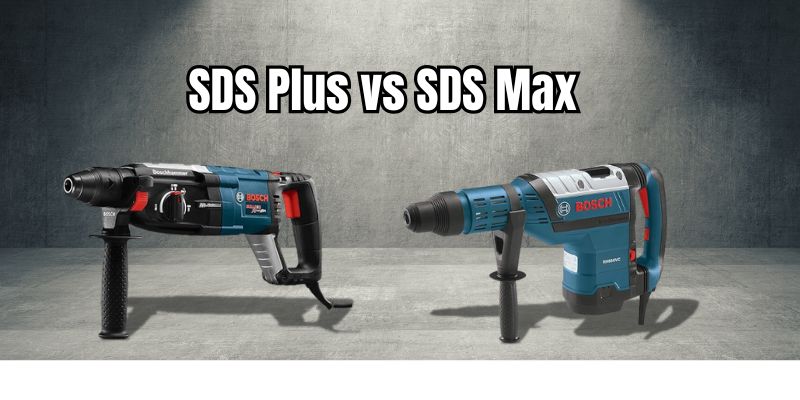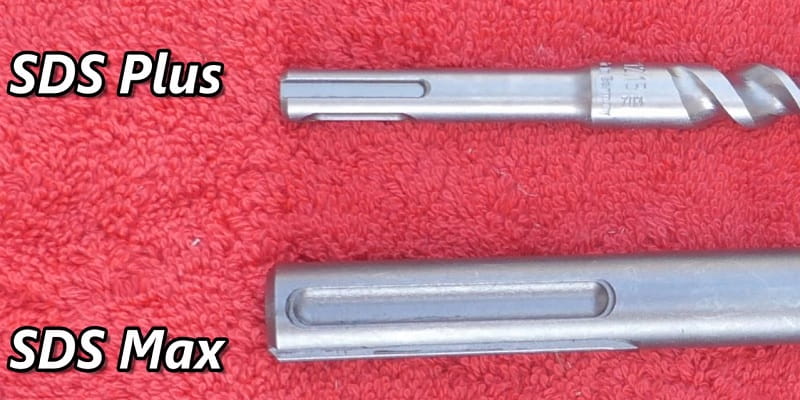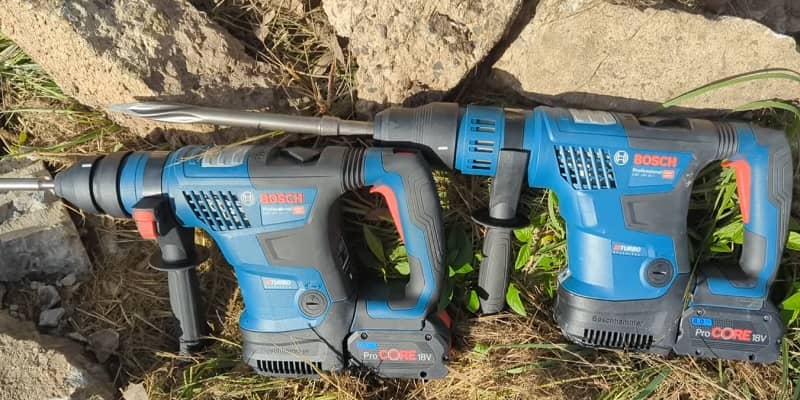If you’ve ever tackled a project involving heavy-duty drilling or concrete work, you’ve likely come across SDS drills. These power tools, with their slotted drive system (SDS), offer superior performance when it comes to drilling into hard materials like concrete and masonry. But within the world of SDS drills, there are different options to choose from—SDS Plus and SDS Max. While both are popular in the construction world, they serve different purposes based on job type, tool compatibility, and the size of the project.
In this article, we’ll dive deep into the differences between SDS Plus and SDS Max. We’ll explore how each system works, where they excel, and help you determine which one is best suited for your needs. Whether you’re a DIY enthusiast looking to upgrade your tools or a professional contractor, understanding these two options is critical to making the right choice.

What is the SDS System?
Before jumping into the comparison between SDS Plus and SDS Max, it’s essential to understand the SDS system as a whole. SDS, short for Slotted Drive System, was designed in the 1970s by Bosch to improve the efficiency and safety of drilling into tough materials like concrete, stone, and brick.
How SDS Works: The SDS system allows the drill bit to move back and forth in a hammering motion while being securely held in place by the slotted shank. The primary advantage is the drill bit’s ability to slide in and out of the chuck, minimizing wear and tear on the tool and making the system ideal for repetitive, heavy-duty tasks.
SDS Shank Design: The distinctive slotted shank design enables better power transfer and impact during hammer drilling. Unlike traditional drill bits that can slip or jam, SDS bits lock into the chuck without the need for tightening, reducing downtime and improving performance.
The SDS system comes in three main types:
- SDS: The original version, used in older models but less common today.
- SDS Plus: The most popular system for small to medium-duty tasks.
- SDS Max: The larger, more robust version for heavy-duty applications.
What is SDS Plus?
SDS Plus is the most widely used SDS system for light to medium-duty applications. If you’re a DIYer or a homeowner doing construction around the house, chances are you’ll be working with SDS Plus tools.
Key Features of SDS Plus:
Shank Design: The SDS Plus bit’s shank has a 10mm diameter and 4-slot design that locks into the rotary hammer drill, allowing for efficient power transfer during drilling and chiseling. The 4 slots allow the bit to securely move in a piston-like action, ideal for drilling into materials like concrete and masonry.
Bit Sizes: SDS Plus bits come in diameters typically ranging from 5 mm to 30 mm, with lengths varying to accommodate different drilling depths. These smaller bits make SDS Plus ideal for tasks like installing anchors or drilling holes for screws.
Power and Tool Compatibility: SDS Plus drills and bits are typically used in light to medium-duty rotary hammers with a power output of up to 4 joules of impact energy. This makes them compatible with smaller, more portable power tools that are easier to handle.
Common Uses: SDS Plus is perfect for jobs around the house or on smaller construction sites. Here are a few common applications:
- Drilling holes for bolts or anchors in concrete.
- Light chiseling in brickwork or tile removal.
- Drilling into masonry for wiring or plumbing installation.
Advantages of SDS Plus:
Affordability: SDS Plus tools and bits are more affordable than their SDS Max counterparts, making them a better option for hobbyists or contractors on a budget.
Portability: Since SDS Plus tools are lighter and smaller, they are much easier to carry around and use in tight spaces.
Versatility: SDS Plus bits can handle a wide range of applications, making them ideal for general construction, home repairs, and DIY projects.
7 Best SDS Plus Rotary Hammer Drill
- Milwaukee 2715-20 M18 SDS Plus Rotary Hammer
- DEWALT DCH273B 20V MAX SDS Rotary Hammer Drill
- AOBEN 1-1/4 Inch SDS-Plus Rotary Hammer Drill
- BOSCH 11255VSR Bulldog Xtreme SDS-Plus Rotary Hammer
- Makita XRH04Z 18V LXT SDS-PLUS Rotary Hammer
- GLORITY SDS-Plus Heavy Duty Rotary Hammer Drill
- BOSCH RH328VC 1-1/8 Inch SDS-plus Rotary Hammer
What is SDS Max?
While SDS Plus is perfect for light to medium-duty work, SDS Max steps in when heavy-duty jobs are on the agenda. SDS Max is designed for the toughest materials and the most demanding applications.
Key Features of SDS Max:
Shank Design: The SDS Max bit’s shank has an 18mm diameter and 5-slot design that provides a stronger connection between the bit and the rotary hammer drill. This design allows the tool to deliver more impact energy and sustain higher levels of torque, making it capable of handling the most challenging tasks.
Bit Sizes: SDS Max bits are typically larger, with diameters ranging from 12 mm to 45 mm or more, and lengths extending for deep drilling applications. This larger size makes them ideal for heavy-duty work, such as drilling large holes in thick concrete slabs or walls.
Power and Tool Compatibility: SDS Max rotary hammers are much more powerful, often delivering over 8 joules of impact energy. These tools are larger, heavier, and require more power to operate, making them suitable for industrial and large-scale construction projects.
Common Uses: SDS Max excels in environments where precision and power are critical. Here are some typical uses:
- Demolition work: Breaking up concrete slabs or removing old masonry structures.
- Heavy chiseling: Removing thick layers of tiles or working on stone structures.
- Large-hole drilling: Boring larger holes for pipes or cables in construction projects.
Advantages of SDS Max:
Durability: SDS Max tools are built to last, even under constant use in challenging environments.
High Impact Power: The additional power and torque allow for faster and more efficient drilling, reducing labor time.
Precision in Heavy-Duty Jobs: Despite their power, SDS Max drills offer precise control, essential when dealing with large-scale projects.
7 Best SDS Max Rotary Hammer Drill
- BOSCH RH540M 1-9/16 Inch SDS-Max Rotary Hammer
- Makita HR4002 1-9/16″ SDS-MAX Rotary Hammer
- BOSCH RH850VC 120V SDS-max Rotary Hammer with Vibration Control
- DEWALT D25481K SDS MAX Rotary Hammer
- Hilti 3493739 TE 60 120-volt SDS Max Rotary Hammer
- Berserker 1-9/16″ SDS-Max Heavy Duty Rotary Hammer
- Metabo HPT DH40MC SDS Max Rotary Hammer
SDS Plus vs SDS Max: What Are the Differences?
Now that we’ve covered the features of SDS Plus and SDS Max, let’s dig into a head-to-head comparison to better understand where each system fits.
Shank Design:

- SDS Plus: 10mm and 4 slots in the shank for smaller, lightweight jobs.
- SDS Max: 18mm and 5 slots for heavy-duty applications, providing more stability and strength.
Bit Size:
- SDS Plus: Small to medium-sized bits (5 mm to 30 mm diameter) for precision work.
- SDS Max: Larger bits (12 mm to 45 mm diameter) designed for deeper drilling and tougher materials.
Recommended Drill Bits
Tool Size and Weight:
- SDS Plus: Smaller, more portable tools, weighing less and requiring less power.
- SDS Max: Larger, heavier tools with higher power requirements, best suited for industrial applications.
Impact Energy:
- SDS Plus: Up to 4 joules of impact energy.
- SDS Max: Over 8 joules, delivering more force for faster, more efficient work.
Common Applications:
- SDS Plus: Residential jobs, light chiseling, installing anchors, and masonry drilling.
- SDS Max: Demolition, heavy chiseling, drilling large holes in thick concrete, and industrial construction.
Interchangeability of SDS Max with SDS and SDS Plus
SDS Max is not interchangeable with SDS Plus due to size and design differences. You cannot fit an SDS Max bit into an SDS Plus rotary hammer, as they are designed for different scales of work. However, it is possible to use an adapter to bridge the gap between these systems.
For instance, an SDS Plus to SDS Max adapter allows you to use SDS Plus bits in an SDS Max tool, while an SDS Max to SDS Plus adapter enables the use of SDS Max bits in SDS Plus tools. Both types of adapters are readily available, making it easier to switch between the two systems when needed, though performance may be optimized when matching bits and tools of the same system.
Choosing Between SDS Plus and SDS Max – When and Why?
Choosing between SDS Plus and SDS Max depends on the type of job, the material you’re working with, and your long-term needs. Both systems have their strengths, and understanding which one is right for your project can save time, money, and effort. In this section, we’ll break down when you should choose SDS Plus versus SDS Max and why.

When to Choose SDS Plus
SDS Plus is ideal for light to medium-duty tasks. It’s more than enough for most home improvement projects, light construction work, and tasks where portability and ease of use are important. If you’re looking for a tool that’s affordable, versatile, and easy to manage, SDS Plus is the way to go.
Common Use Cases for SDS Plus:
- Home Renovation and DIY Projects: If you’re doing things like installing shelves, hanging artwork, or drilling into masonry for electrical work, SDS Plus is perfect. It’s compact, lightweight, and powerful enough for these jobs, without being overkill.
- Installing Anchors and Bolts: For tasks that require precision drilling into concrete or masonry, like installing anchors for shelving or bolts for frames, SDS Plus is your go-to tool. The smaller bit sizes allow for greater accuracy in tight spaces.
- Light Chiseling Work: If you’re removing tiles or light masonry, SDS Plus is sufficient. The hammering action combined with smaller chisels allows for easy removal without causing excessive damage to surrounding materials.
- Portability and Ease of Use: Contractors who need to move around job sites frequently, or hobbyists who need a versatile tool that can do a bit of everything, will appreciate the portability of SDS Plus tools. They’re smaller, lighter, and easier to use in confined spaces.
- Budget-Friendly Option: SDS Plus tools and bits are generally more affordable than SDS Max, making them a great choice if you’re looking for a good balance between cost and performance. They offer enough power for a variety of tasks without the hefty price tag associated with heavier tools.
SDS Plus Tips:
Use the right speed and force settings: Depending on the material, adjust your tools settings to avoid overdriving or underperforming.
When to Choose SDS Max
On the other hand, SDS Max is the right choice when you’re facing heavy-duty jobs. It’s built for tasks that require more power and larger drill bits. If you’re working on a major construction site, dealing with thick concrete, or involved in industrial applications, SDS Max will provide the durability and force you need.
Common Use Cases for SDS Max:
- Demolition Work: If your project involves breaking up old concrete slabs or demolishing masonry structures, SDS Max should be your tool of choice. The higher impact energy and larger chisels can handle heavy chiseling and breaking with ease. Jobs that require tearing down thick walls or floors are where SDS Max shines.
- Drilling Large Holes in Concrete: SDS Max is excellent for drilling large-diameter holes, typically for pipes, ducts, or wiring channels in concrete walls or floors. The larger bit sizes and powerful motor ensure quick and efficient drilling, even in tough materials.
- Removing Thick Layers of Material: When you’re working with stone, tile, or masonry and need to remove thick layers quickly, SDS Max tools provide the force and endurance necessary for such demanding tasks. The extra power prevents the tool from overheating during extended use, making it ideal for big jobs.
- Commercial and Industrial Use: On construction sites where time is money, SDS Max is often the preferred choice. The ability to deliver high impact power while maintaining precision helps reduce the time spent on large-scale projects. If you’re a contractor handling concrete or stone regularly, SDS Max is a worthwhile investment.
- Durability for Continuous Use: SDS Max tools are built to withstand heavy, continuous use. Their robust construction and higher torque ratings make them ideal for long-term projects where downtime isn’t an option. If you need a tool that will last through countless drilling and chiseling tasks, SDS Max is your best bet.
SDS Max Tips:
Ensure proper safety gear: Due to the size and power of SDS Max tools, it’s important to wear appropriate safety gear, including goggles, gloves, and hearing protection.
Making the Right Choice: Key Considerations
When deciding between SDS Plus and SDS Max, consider the following key factors:
Job Size and Material:
- If you’re working with thin concrete, masonry, or stone on a small scale, SDS Plus is enough to get the job done.
- If you’re dealing with thick concrete slabs, large stones, or heavy demolition work, SDS Max will offer the power and durability required.
Portability vs Power:
- SDS Plus tools are smaller, lighter, and more portable, making them ideal for moving around job sites or working in confined spaces.
- SDS Max tools are heavier and more powerful, designed for larger projects where moving the tool around isn’t as critical.
Frequency of Use:
- For occasional home improvement or DIY tasks, SDS Plus offers enough performance without the extra cost or weight.
- For frequent or daily use in tough environments, SDS Max tools are designed to hold up under repeated heavy use.
Cost Considerations:
- SDS Plus is typically less expensive, both in terms of the tool itself and the drill bits, making it a more budget-friendly option for casual users.
- SDS Max is more expensive but offers better performance and durability for heavy-duty tasks. If you need high impact energy and larger bit sizes, the extra cost is justified.
SDS Plus vs SDS Max: Which One is Right for You?
The decision between SDS Plus and SDS Max ultimately comes down to the type of work you do and how often you do it. If you’re a homeowner or DIY enthusiast, SDS Plus offers a great balance of power, affordability, and portability. It’s perfect for small to medium jobs, and you can easily find compatible tools and bits for a wide range of tasks.
On the other hand, if you’re a professional contractor or involved in heavy-duty construction projects, SDS Max is a must-have. The extra power, larger bits, and durability make it ideal for jobs where precision and force are critical.
By understanding the strengths of each system and the specific requirements of your project, you can make an informed decision and choose the best SDS system for your needs.
Read Also: Rotary Hammer vs Hammer Drill
Conclusion
In summary, both SDS Plus and SDS Max are excellent systems, each tailored to specific types of tasks. If you need versatility and ease of use for light to medium work, SDS Plus is the way to go. But if your projects require heavy-duty performance and power, SDS Max is the clear winner. With the right tool in hand, you’ll tackle any job with efficiency and precision, making your work easier and faster.
FAQs
What’s the difference between SDS Plus and SDS Max drills?
SDS Plus drills are smaller and work best for holes up to 1 inch wide. They’re good for home jobs and light work. SDS Max drills are bigger, more powerful, and drill holes up to 2 inches wide. They’re built for heavy construction and longer jobs.
Why does my SDS drill make a loud clicking noise?
A clicking sound is normal when the hammer function is on – it’s the impact mechanism working. But if you hear unusual loud clicks or grinding noises, check if your bit is locked properly. If the noise continues, your drill might need new parts or service.
Can I use the same bits in SDS Plus and SDS Max drills?
No, SDS Plus and SDS Max bits have different sizes. Each type fits only its matching drill. The bits have different groove patterns and sizes. Using the wrong bit directly can damage your drill. But see here we mentioned above – you can use special adapters: an SDS Plus to SDS Max adapter lets you use Plus bits in Max drills, and a Max to Plus adapter lets you use Max bits in Plus drills. Remember, using matching bits and drills works best.
How often should I clean my SDS drill?
Clean your SDS drill after each use. Remove dust from air vents with a brush, wipe the chuck clean, and oil the bit holder monthly. This stops dust build-up, keeps the drill working well, and makes it last longer. Don’t forget to empty the dust collector if your drill has one.
Should I use water when drilling into concrete with my SDS drill?
Yes, spraying a little water helps when drilling concrete. It keeps the bit cool, reduces dust, and helps you drill better. But don’t let water get into the drill. You can also use a vacuum or helper to clear dust, or buy special dust collection attachments.
What safety gear do I need when using an SDS drill?
Always wear safety glasses to protect from flying bits and dust. Use ear protection – SDS drills are loud. Wear a dust mask when drilling concrete. Put on work gloves to reduce vibration effects. Keep a firm grip and use both hands on the drill.


